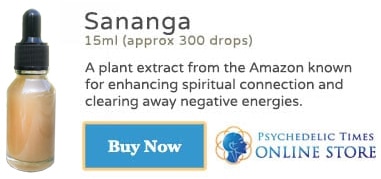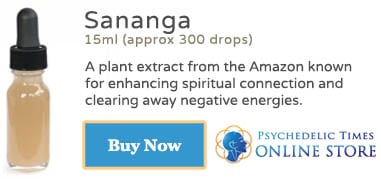
Sananga shows great promise to treat a wide range of conditions affecting the eyes. Image Source: Flickr CC user Conal Gallagher
When I first heard about sananga eye drops from a friend who used it as a precursor ritual to an ayahuasca ceremony, I was curious to understand how exactly the plant-based eye medicine worked. If you were to ask a shaman, sananga sounds like a sort of panacea. The plant-based sananga eye drops—brewed from the Tabernaemontana genus of shrubs native to the upper Amazon—are said to enhance eyesight and have long been used by indigenous tribes to prevent and treat ocular diseases like glaucoma, cataracts, near-sightedness, and blindness. But sananga is also commonly used to treat skin diseases, infections, arthritis, cancer, and perhaps most interestingly, to clear a person of what is called panema—anxiety, depression, bad luck, negative energies, and laziness.
In fact, it’s by clearing this panema that sananga is said to promote overall eye health. As a shaman would explain it, sananga does its work not at the physical or cellular level but rather on an energetic level. That’s how sananga is explained from the shamanic perspective, but where does science stand on its merit? Next to plant medicines like psilocybin mushrooms or ibogaine, the research on sananga is comparatively slim, but some studies provide clues as to why the sananga eye drops may be powerful medicine. While shamans may describe it as energetic healing, studies dating to the 1970’s show that shrubs in the Tabernaemontana genus have a variety of pharmacological properties that could help explain sananga’s ability to foster healthy vision.

Understanding the Species of Sananga
The specific ingredients of sananga change depending on the particular tribe preparing it, and people say the effects also differ slightly. The sananga eye drops used most popularly today is prepared in the tradition of the Matsés tribe with the species Tabernaemontana undulata (called becchete in the local language). People describe the effects as comparable to the entheogenic qualities of ibogaine but less intense. Unfortunately, there’s very little research to be found on this species—the only studies on T. undulata deal with the plant’s botanical attributes rather than its medicinal qualities.
The Ticuna and Kaxinawá tribes, on the other hand, use the closely related species Tabernaemontana sananho (called kunakip) to make sananga, which is even gentler than T. undulata. And this species has been studied—a 1998 study on medicinal plants in Ecuador showed that T. sananho had anti inflammatory properties, which would support the popular idea that the medicine is an effective treatment for arthritis. Another study from 2007 showed that T. sananho was effective in treating skin infections thanks to its antimicrobial properties.
Sananga’s ability to improve vision is its most well-known attribute, but it’s also the least studied. Still, even the sparse scientific research about its antiinflammatory and antimicrobial properties support the theory that it could be a powerful treatment for eye infections. And when you widen the research to include other members of the Tabernaemontana genus, the evidence is even more promising.
The Medicinal Roots of the Tabernaemontana Genus
While the two species used most commonly for sananga haven’t been researched as thoroughly, the Tabernaemontana genus as a whole has been studied since the 1970’s. This genus has shown some powerful medicinal potential, and while we can’t assume that the sananga species share all the same properties, it does provide interesting fodder in the discussion for how and why exactly sananga works to treat ocular problems.
Studies on the Tabernaemontana genus have shown the following properties:
- Antimicrobial: Studies from 1984 and 2002 show that the species T. pachysiphon and T. angulata have antimicrobial properties effective against a variety of bacteria. The bacteria species targeted include Staphylococcus aureus, which can cause skin infections and respiratory infections, and Pseudomonas aeruginosa, a notoriously drug-resistant bacteria linked to pneumonia, sepsis, and eye infections in people who wear contact lenses.
- Antifungal: A 2009 study showed that extracts of T. stapfiana was effective against a variety of fungi species, including Candida albicans, a yeast that can cause thrush in the mouth and yeast infections in the vagina. While Candida infections are typically easy to treat, the fungus poses risk to people with compromised immune systems.
- Antioxidant: The Tabernaemontana genus also has strong antioxidant properties. While nutritional antioxidants are widely known for their value in maintaining general health, ongoing research also suggests antioxidants could play a critical role in preventing age-related ocular problems like cataracts and macular degeneration.
- Anti-cancer: Studies dating back to 1977 have shown promising results that Tabernaemontana species could help combat cancer. The African species T. elegans was shown to be particularly effective at killing cancer cells.
- Anti-inflammatory: A 2003 study showed that T. pandacaqui had fever-reducing and anti-inflammatory qualities and was also quite effective at blocking pain signals.
Weaving Science with Indigenous Wisdom
It’s true—we can’t yet infer any solid conclusions about sananga from the pieced-together research. But the number of studies on the health properties of the Tabernaemontana genus—not to mention sananga’s long history of experiential evidence—make a strong case that the plant medicine is indeed a powerful healer and, most importantly, more than worthy of further research. The mix of studies on the genus as a whole show a vast spectrum of promising medicinal qualities, but given the growing popularity of sananga, a concentrated focus on the properties of T. undulata and T. sananho and is more warranted than ever.
Over the last two decades, during what some have called a modern renaissance of psychedelic research, the fields of Western science have seen an interesting phenomenon. Science, which has historically been dismissive of the psychospirituality inherent in many of the world’s indigenous cultures, has started to turn out studies that validate the wisdom of cultures that have used psychedelics and other plant medicines for generations. So while sananga eye drops are often described in terms of energy blockages or its ability to cleanse and center the body, mind, and spirit, it could be only a matter of time before science can explain its benefits in pharmacological terms.










